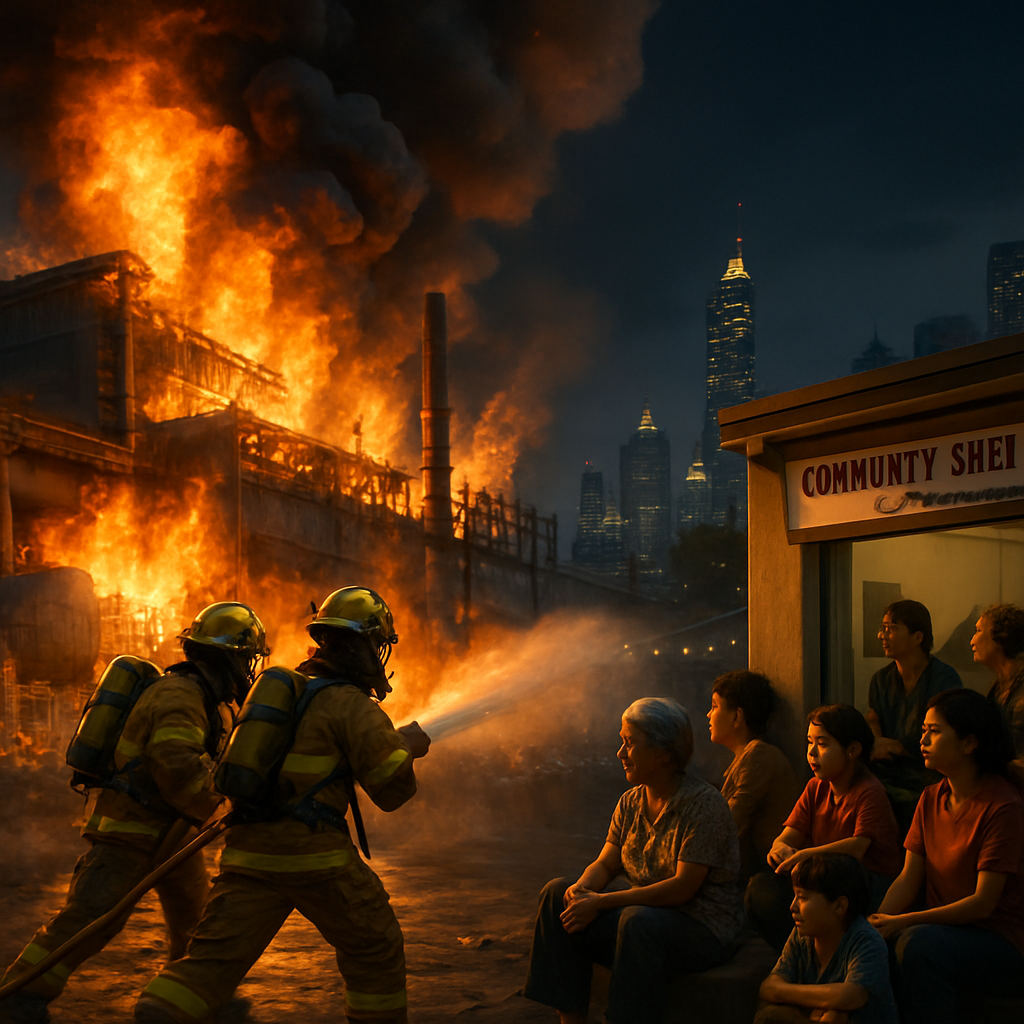As dawn broke over Bangkok on Monday morning, the skyline was ominously streaked with plumes of smoke billowing from a catastrophic fire in Lat Krabang district. What began as a daunting spectacle on Sunday evening had transformed by the next day into a relentless inferno at a vast furniture manufacturing plant, sending waves of anxiety through nearby communities that had to evacuate for safety.
This blaze wasn’t your typical flash-in-the-pan — it roared with an unbridled ferocity largely due to the ample supply of fuel courtesy of the factory’s inventory. Deep in the factory basement, a clandestine stockpile of furniture and plastic pellets lay in wait, igniting as if summer had come early. The building was an arsenal of combustible materials: plywood, cardboard boxes, and pallets, forming a pyre worthy of ancient rituals.
By Monday morning, the scene was hellish, with the factory resembling a smoldering cauldron that belied control. Firefighters battled valiantly, yet the whirlwind of extreme heat and smoke was unyielding. Over thirty fire engines bore witness to this unwinnable contest, their efforts no match for mother nature’s fury. As firefighters unleashed torrents of foam and water, the smoke thickened, like a magician’s trick gone awry.
Bangkok council president Surajit Pongsingwithaya was on site, his expression a mix of determination and concern, as he detailed the enormous challenge faced by his team. Miraculously, and perhaps due to some stroke of luck, there were no injuries reported — Mother’s Day, falling conveniently on this fateful date, meant a public holiday had spared the workforce.
For six communities in the plant’s periphery, however, the situation was anything but serene. Residents were hurriedly evacuated amidst choking heat and toxic fumes. Neighbors, arm in arm with rescue workers, made their way to shelters including Wat Lampong School, Wat Thippawat, and a nursery within the Wat Thippawat community; each serving as makeshift refuges providing solace amongst chaos. Many evacuees, hearts heavy, implored rescuers to retrieve beloved pets left behind.
Suriyachai Rawiwan, City’s disaster mitigation chief, added gravity to the situation. The factory’s steel bones groaned and creaked ominously, while the walls threatened to join the chorus, cracking under the immense pressure. His concern was palpable, seeing the structural integrity ebb away amid the blistering siege.
This unrelenting drama in Lat Krabang district has transformed into a testament to resilience and community spirit. As the fire continues to wage its war, it also unites neighbors and emergency responders in a shared goal — safeguarding lives amid flames and, they hope, rising from the ashes stronger and wiser than before.


















This is a tragic event for the Lat Krabang community. I can’t believe how devastating fires can be with those kinds of materials present.
I agree, Samantha. The factory should have had better safety measures in place to prevent such disasters.
Absolutely, James. It’s concerning how such places operate without proper regulation.
I read that many factories don’t comply with safety standards. When will we learn from these incidents and take action?
It’s often about profits over safety, technerd89. Until the government enforces stricter penalties, nothing will change.
This incident also highlights the environmental impact. Pollution from such fires is a significant problem.
Is it just me, or did the emergency services seem underprepared for dealing with something of this scale?
Emergency services did their best given the situation, but yes, better planning could have mitigated some damage.
I hope they learn from this disaster and improve their response strategies.
The fact that no injuries were reported is a miracle. It’s Mother’s Day so most workers were home with their families.
I wonder if the factory’s management will face any consequences. Seems like gross negligence to me.
I hope so, but these things often get swept under the rug, unfortunately.
Why weren’t there any fire alarms or sprinklers? This should be a basic requirement in any factory.
I doubt alarms or sprinklers would have made a huge difference in a blaze of this size, unfortunately.
It’s heartwarming to see the community come together like this. Amidst tragedy, people really show their kindness.
Absolutely, Maxwell. The human spirit truly shines in times of crisis.
Yes, but we shouldn’t wait for disasters to foster such unity. It should be an everyday norm.
I hope they manage to save the pets left behind. It must be heartbreaking for those families.
The rescue teams usually do a great job with pets, but it’s often tough in such chaos.
What about air pollution? This fire is contributing to already poor air quality in Bangkok.
Short-term health effects are a concern, especially for those with pre-existing respiratory issues.
Fires like these remind me of the Great Chicago Fire. Hopefully, we’ll learn and prevent future tragedies.
Good point! History is full of lessons, we just need to pay attention to them.
The resilience of people is commendable, but it’s sad we have to keep proving it through these disasters.
I can’t even imagine the loss some of these families are experiencing. It’s not just material, it’s emotional too.
True, the emotional toll can be the worst part. Memories attached to homes can’t be replaced.
Fires like these are bound to happen when facilities don’t adhere to safety standards. It’s pure negligence.
Let’s hope there’s enough insurance coverage to help rebuild and support those affected.
What about the psychological impact on the evacuees? Such trauma can have long-term effects.
Many might need counseling to overcome this ordeal, especially children.